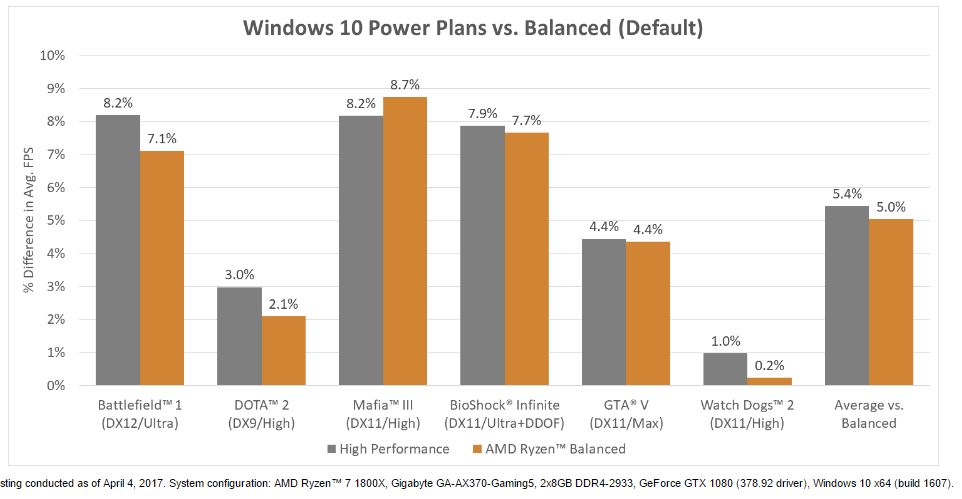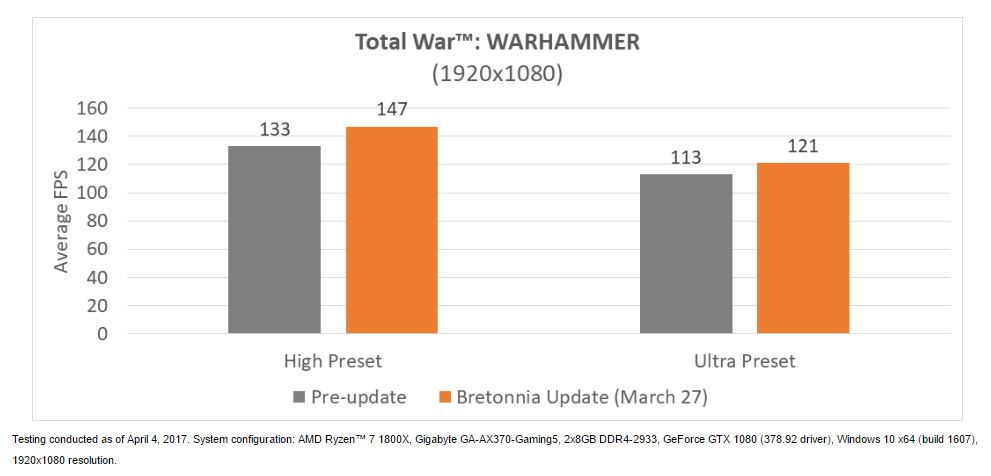AMD's Ryzen Receives New Power Plan, Game Patch
AMD's Ryzen launch has brought us a new lineup of eight-core processors with disruptively low price points, but the relationship between performance and price is inextricably intertwined. Ryzen excels at workstation applications, but its curious gaming performance trends have dominated the conversation. We've recorded lower than expected performance in several titles, and after a bit of experimentation, we found that part of the problem stems from the Windows power profile. AMD has also stated that many games have difficulty navigating its unique cache and core topology, which requires specific optimizations delivered via patches. AMD announced in a blog post that it created a new Windows profile to address the power issue, and also announced that a third game received a performance-boosting patch.
Turn Up The Voltage!
Processors employ voltage and frequency gating to conserve energy. The processor has several pre-defined voltage and frequency settings, called P-States, which it applies on a per-core basis. In the interest of preserving performance as much as conserving power, the processor can dynamically switch cores into various P-States based upon the current environment, but lower power states result in longer resumption times. P-State transitions can occur during gaming sessions, and when your application catches the CPU sleeping, it results in reduced performance.
Several Windows power profiles, such as power saver and balanced, allow the operating system to decide when to transition between states. The key issue revolves around latency--there is up to a 30ms delay between when the operating system orders a power transition and the processor acts upon it. The delay varies based upon power plan parameters. Switching to the high performance power profile hands the power management tasks back to the processor. With sole control of its own power states, a modern processor can transition between the various sleep states in 1ms, which reduces the performance problem. Unfortunately, it isn't as power efficient.
AMD's solution? A middle ground, of sorts. AMD's new Ryzen Balanced power plan reduces timers and thresholds for P-state transitions to improve performance, and according to AMD-provided information, it yields similar performance to the Windows high performance power profile.
You can download the new power profile from AMD's blog post and install (and select) it. AMD will also bundle the new power plan in the next iteration of its chipset drivers. AMD didn't list a specific date for the new chipset driver release, but the package will install the new power plan and enable it automatically. Samsung also takes a similar tack with its Samsung power profile for SSDs, so the approach isn't without precedent.
The AMD Ryzen™ Balanced power plan still permits aggressive power management. There should be little difference between the OEM Balanced and the Ryzen Balanced plan. We’re interested in your feedback!Performance of the AMD Ryzen™ Balanced power plan should be on par with the High Performance plan. We're interested in your feedback on this, too.Finally, if you see a third-party tool reporting “idle” clocks in the range of 3200-3400MHz, you can be virtually certain that the core is actually sleeping and the tool is simply reporting the last known P-State.
AMD is looking for feedback before it rolls the new power plan into the chipset drivers, so we might see more tailoring over time. AMD hasn't quantified the impact to power consumption and thermals, but indicates it is similar to the existing balanced power profile. It remains to be seen how this will impact users that employ other custom profiles, such as Samsung's SSD profile. As far as we know, you can't run two power profiles simultaneously.
Get Tom's Hardware's best news and in-depth reviews, straight to your inbox.
Total War: Warhammer Gets A Ryzen Facelift
AMD's new Zen architecture serves as the underlying foundation for Ryzen processors, but many games have difficulty with its unique SMT implementation and topology. As such, targeted optimizations to the code base should yield improved performance. A few developers, such as Stardock/Oxide with Ashes of the Singularity: Escalation and Valve with DOTA 2, have already issued performance-boosting updates. We tested the new Ashes of the Singularity: Escalation update and found that it does provide significantly better performance, which is a promising development.
During the Ryzen launch, Creative Assembly also announced its intentions to optimize for the Zen architecture. The company released the Bretonnia patch for Total War: Warhammer and AMD provided a few benchmarks to quantify the performance increase. Interestingly, AMD notes that the patch improves thread scheduling:
The March 27th Bretonnia update helps the underlying game engine better understand the topology of Ryzen with respect to the number of logical vs. physical cores. Overall, this helps Total War: WARHAMMER better schedule threads on the processor to reduce resource contention.
AMD has previously stated that the Windows 10 scheduler is not at fault for Ryzen's reduced performance, so the thread scheduling disparity is obviously at the application level. A third developer coming forward to support the new architecture is promising, and hopefully more follow suit.
The Master Is Ryzen
AMD's Ryzen Master is a simple software-based overclocking tool, but it currently requires HPET (High Precision Event Timer) for accurate reporting. Surprisingly, AMD recommends that you disable HPET for the best performance in games, which means you will have to switch back and forth to get the best gaming performance and also use the Ryzen Master tool.
Ryzen Master now reports junction temperature, rather than tCTL, by automatically removing the tCTL offset on the AMD Ryzen 1800X, 1700X, and 1600X processors. See the “temperature reporting” section of this blog for more context on tCTL.The installer no longer enables or requires HPET when Ryzen Master is installed with a system running an AGESA 1.0.0.4-based BIOS. See the “let’s talk BIOS updates” section of this blog for more context on AGESA 1.0.0.4.
No more of that. AMD issued a new updated tool that breaks it free from its HPET chains, provided that you have an AGESA 1.0.0.4-based BIOS. It also reports temperature more accurately now, too.
Thoughts
AMD's promise of a rash of game updates to improve performance was met with skepticism, but the situation appears to be improving nicely. We hope to see more developers come forward in the coming months, and we likely will.
AMD's Ryzen is a nice silicon canvas, but as with any new architecture, it will take some time before the picture is complete. In the meantime, Ryzen 5 processors launch next week. We are busy testing. Stay tuned.

Paul Alcorn is the Editor-in-Chief for Tom's Hardware US. He also writes news and reviews on CPUs, storage, and enterprise hardware.
-
manleysteele AMD not being satisfied with resting on their laurels is great news for the consumer. The initial launch was brilliant with a few caveats. This continuing tuning to address those "caveats" is quite promising.Reply -
artk2219 I would be curious to see a launch vs now article within 6 months, to see how the state of the AM4 platform has changed by then. It seems like it will be interesting for sure. Also a generational round up like Toms did back in 2013 would be awesome.Reply -
manleysteele Reply19532804 said:I would be curious to see a launch vs now article within 6 months, to see how the state of the AM4 platform has changed by then. It seems like it will be interesting for sure. Also a generational round up like Toms did back in 2013 would be awesome.
I second this motion. All in favor, say "aye." -
artk2219 Reply19532916 said:19532804 said:I would be curious to see a launch vs now article within 6 months, to see how the state of the AM4 platform has changed by then. It seems like it will be interesting for sure. Also a generational round up like Toms did back in 2013 would be awesome.
I second this motion. All in favor, say "aye."
Lol aye, I just found the articles I was referring to. These were great for pointing to the strengths and weaknesses of several chips, but im sure it took forever to actually compile the results and write.
http://www.tomshardware.com/reviews/piledriver-k10-cpu-overclocking,3584.html
http://www.tomshardware.com/reviews/ivy-bridge-wolfdale-yorkfield-comparison,3487.html
http://www.tomshardware.com/reviews/gaming-processor-frame-rate-performance,3427-9.html
-
lsatenstein I use Linux. Are there any Linux based AMD studies? What do I do with Linux? Coding, some games, Viewing videos.Reply
If you do the comparison, setup a 1700 non-gamer's system and compare that system to an equivalent Intel system.
I am interested in a cost comparison. Do I remain an Intel user, or do I switch?
And then, for speculation, what is Intel planning as a competitive offering? -
Gillerer Reply19535820 said:I use Linux. Are there any Linux based AMD studies? What do I do with Linux? Coding, some games, Viewing videos.
Level1Techs has some Ryzen CPU and motherboard videos with a Linux perspective.
Long story short, they recommend Ryzen for Linux for productivity/coding use, except currently (and with current motherbord BIOSes) there is some trouble getting IOMMU/PCIe passthru working in case you want dedicated graphics cards for virtual machines (both GPUs are currently assigned to the same IOMMU group). AMD and motherboard vendors should be looking into it, though. -
artk2219 Reply19535820 said:I use Linux. Are there any Linux based AMD studies? What do I do with Linux? Coding, some games, Viewing videos.
If you do the comparison, setup a 1700 non-gamer's system and compare that system to an equivalent Intel system.
I am interested in a cost comparison. Do I remain an Intel user, or do I switch?
And then, for speculation, what is Intel planning as a competitive offering?
Phoronix should have some interesting reviews for you on their site. Check it out and it'll help you make those other decisions.
http://www.phoronix.com/scan.php?page=article&item=amd-ryzen-cores&num=1
-
dusty13 "Ryzen excels at workstation applications, but its curious gaming performance trends have dominated the conversation."Reply
yeah ... curious gaming performance indeed ...
unnoticeable in fact in 100% of real life scenarios, because the difference between 150 and 125 fps is just irrelevant.
also have you checked your data lately? the web is full of rather massive increases (still in totally irrelevant as 100fps plus) performance with the latest batch of bios upgrades by everyone but tomshardware. you may want to do some work and get up to date with actual facts now and again.
aren't you getting tired of that totally constructed topic by now? -
lsatenstein Dusty13.Reply
Since we can't get our hands on the new hardware as yet, whatever we obtain from Tom's hardware is of interest. Every week, there are new readers to Tom's, while some bored readers drop off.
I choose to read the topics of interest, and skip the rest. I also do have financial priorities, and spending 2 thousand on a gaming system is not one of them. Tom's hardware does not have infinitely deep pockets. The benchmarks done before write-up of the experience is not trivial, but many days of work. While I do not reside in the USA, I can't take advantage of the advertisers promoted herein. I have to rely on local suppliers. So yes, Toms postings are relevant to me, a system application developer. -
Davil Finally they can challenge Intel again. I always like the competition and hopefully this will make Intel come up with something better or at least start using better TIM on all their IHS's.Reply


